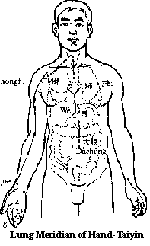TCM Theory: Channels and Collaterals
- Brief Introduction
- Twelve Regular Meridians
- Du Meridian and Ren Meridian
Brief Introduction
Channels and collaterals are an important component part in the basic theory of Traditional Chinese Medicine(TCM). It has the guiding significance in various clinical branches, particularly in the clinical Acupuncture treatment.
Jing Luo is a general term of Jingmai(meridians) and Luomai (collaterals) in the human body. The differentiation of meridians from collaterals is that Jingmai (meridians) is the main stem of the meridians and collaterals which circulates straightly and distributes in the deeper layer as like the Stomach Meridian of Foot-Yangming connecting the superior, inferior, internal and external. On the contrary, luomai (collaterals)is the branch of the meridians which circulates traversely and obliquely in the shadow layer as like the Lung Meridian of Rand-Taiyjn, thinner and smaller, and runs over the whole body in a crisscross fashion.
Jing Luo Function: meridians and collaterals belongs to internal organs(Zang-fu) and exteriorly to all the extremities. It functions as organic corresponding network between internal organs and body surface. So the human body is an organic whole. Meridians and collaterals serve as the route of Qi and blood, Yin and Yang, all of which keep the body in a well-balanced condition.
The theory of Jing Luo(meridians and collaterals) is rich in contents: the twelve regular Jingmai(meridians) and the twelve subsidiary Jing type of the twelve meridians, the twelve Jing Jin (muscle meridian) and the twelve Pi Bu(cutaneous areas).
Luomai(collaterals) includes the fifteen collaterals, minute collaterals and superficial collaterals. Generally, they are called fourteen regular Jingmai(meridians).
Twelve regular Jingmai(meridians) Nomenclature: Twelve regular Jingmai include three Yin Meridians of Hand, three Yang Meridians of Hand, three Yang Meridians of Foot, and three Yin Meridians of Foot.
Twelve regular Jingmai(meridians) runs in an regular manner: These meridians have their own principles of distribution
The three Yin Meridians of hand run from the chest to the hand.
The three Yang Meridians of hand run from the hand to the head.
The three Yang Meridians of Foot run from the head to the foot.
The three Yin Meridians of Foot run from the foot to the abdomen
Twelve Regular Meridians
1.Tie Lung Meridian of Hand-Tajyin
Circulation and Distribution: The Lung Meridian of Hand-Tajyin originates from the middle jiao, runs downward to connect with the large intestine. Winding back, it goes along the upper orifice of the stomach, passes through the diaphragm, and enters the lung, the organ it pertains to. From the portion of the lung connecting with the throat, it comes out transversely. Descending along the medial aspect of the upper arm, it reaches the cubital fossa. Then it goes continuously downward along the medial aspect of the forearm and  arrives at the medial side of the styloid process of the radius above the wrist, where it enters “cunkou”, the radial artery at the wrist for pulse palpation. Passing the thenar eminence, it goes along its radial border, ending at the medial side of the tip of the thumb.
arrives at the medial side of the styloid process of the radius above the wrist, where it enters “cunkou”, the radial artery at the wrist for pulse palpation. Passing the thenar eminence, it goes along its radial border, ending at the medial side of the tip of the thumb.
The branch proximal to the wrist emerges from lieque and runs directly to the radial side of the tip of the index finger where it connects with the Large Intestine Meridian of Hand-Yangming (Fig 1).
Connection of Zang-fu organs includes large intestine, lung, stomach, and trachea.
Symptom and Indication: This meridian is used for treating diseases of the chest, lung, throat, and trachea. Cough and sore throat are the main symptoms of Lung Meridian. Based on differentiation of syndromes along the meridian Taiyuan and Shaoshang may be selected for puncturing.
2. The Large Intestine Meridian of Hand-Yangming
Circulation and Distribution: The Large Intestine Meridian of Hand-Yangrning starts from the tip of the index finger Shangyang. Running upward along the radial side of the index finger and passing through the interspace of the 1st and 2nd metacarpal bone, it dips into the depression between the tendons. Then, following the lateral anterior aspect of the upper arm to highest point of the shoulder. Then, along the anterior border of the acromion, it goes up to the Dazhui of Du Meridian, and descends to the supraclavicular fossa to connect with the lung. It passes through the diaphragm and enters the large intestine, the organ it belongs to.
The branch from the supraclavicular fossa runs upward to the neck, passes through the cheek and enters the gums of the lower teeth. Then it curves around the upper lip and crosses the opposite meridian at the philtrum. From there, the left meridian goes to the right and the right meridian to the left, to both sides of the nose, where the Large Intestine Meridian links with the Stomach Meridian of Foot-Yangming(Fig 2).
Connection of Zang-fu organs includes lung, large intestine and stomach.
Symptom and Indication: This meridian is used for treating the diseases of head and face, eye, ear, nose, teeth, and throat as well as the diseases of large intestine.
To treat toothache, we can puncture Hegu point. It is effective way.
3. The Stomach Meridian of Foot-Yangming
Circulation and Distribution: The Stomach Meridian of Foot-Yangming starts from the lateral side of ala nasi. It ascends to the bridge of the nose. Turning downward along the lateral side of the nose, it enters the upper gum. Reemerging, it curves around the lips and descends to meet the Ren Meridian at the mentolabial groove. Then it runs posterolaterally across the lower portion of the cheek at Daying. Winding along the angle of the mandible, it ascends in front of the ear and traverses Shangguan. Then it follows the anterior hairline and reaches the forehead.
Branch: The facial branch emerging in front of Daying runs downward to Renying. From there it goes along the throat and enters the supraclavicular fossa. Descending, it passes through the diaphragm, enters the stomach, its pertaining organ, and connects with the spleen.
The straight portion of the meridian arising from the supraclavicular fossa runs downward, passing through the nipple. It descends by the umbilicus and enters Qichong (STSO) on the lateral side of the lower abdomen.
The branch from the lower orifice of the stomach descends inside the abdomen and joins the previous portion of the meridian at Qichong. Running downward, traversing Biguan, and further throught Futu, it reaches the knee, From there, it continues downward along the anterior border on the lateral aspect of the tibia, passes through the dorsum of the foot and reaches the lateral side of the tip of 2nd toe.
The tibial branch emerges Zusanli, 3 cuns below the knee, and enters the lateral side of the middle toe.
The branch from the dorsum of foot arises from Chongyang and terminates at the medial side of the tip of the great toe where it links with the Spleen Meridian of Foot-Taiyin(Fig. 2-3).
Connection of Zang-fu organs includes stomach, spleen, heart, small and large intestine.
Symptom and Indication: This meridian is used for treating the diseases of stomach, intestines and the diseases of nervous system. To treat stomach-ache, Zusanli is often punctured clinically.
4 The Spleen Meridian of Foot-Taiyin
Circulation and Distribution: The Spleen Meridian of Foot-Taiyin starts from the tip of the big toe. It runs along the medial aspect of the foot at the junction of the red and white skin, and ascends in front of the medial malleolus up to the leg. It follows the posterior aspect of the tibia, crosses and goes in front of the Liver Meridian of Foot-Jueyin. Passing through the anterior medial aspect of the knee and thigh, it enters the abdomen, then the spleen, its pertaining organ, and connects with the stomach. From there it ascends, traversing the diaphragm, and running alongside the esophagus. Then it reaches the root of the tongue it spreads over its lower surface.
The branch from the stomach goes upward through the diaphragm, and flows into the heart to link with the Heart Meridian of Hand-Shaoyin(Fig.2-4).
Connection of Zang-fu organs includes spleen, stomach, heart, lung and intestines.
Symptoms and Indication: This meridian is used for treating the diseases of spleen and stomach.
5.The Heart Meridian of Hand- Shaoyin
Circulation and Distribution: The Heart Meridian of Hand-Shaoyin originates from the heart. Emerging, it spreads over the “heart system”. It passes through the diaphragm to connect with the small intestine,
Branch: The ascending portion of the meridian from the “heart system” runs alongside the esophagus to connect with the “eye system.”
The straight portion of the meridian from the “heart system” goes upward to the lung. Then it turns downward and emerges from the axilla. From there it goes along the posterior border of the medial aspect of the upper arm, down to the cubital fossa. From there it descends along the posterior border of the medial aspect of the forearm to the pisiform region proximal to the palm and enters the palm. Then it follows the medial aspect of the little finger to its tip.
Shaochong and links with the Small Intestine Meridian of Hand-Taiyang(Fig. 2-5).
Connection of Zang-fu organs includes heart, small intestine, lung and kidney.
Symptoms and Indication: This meridian is used for treating the diseases of heart, chest and mental disease.
6. The Small Intestine Meridian of Hand-Taiyang
Circulation and Distribution: The Small Intestine Meridian of Hand-Taiyang starts from the ulnar side of the tip of the little finger Shaoze, Following the ulnar side of the dorsum of hand it reaches the wrist where it emerges from the styloid process of the ulna. From there it runs along the posterior border of the lateral aspect of the upper arm to the shoulder joint. Circling around the scapular region, it meets the Du Meridian on the superior aspect of the shoulder at Dazhui. Then, turning downward to the supraclavicular fossa, it connects with the heart. From there it descends along the esophagus, passes through the diaphragm, reaches the stomach, and finally enters the small intestine, its pertaining organ.
The branch from the supraclavicular fossa ascends to the neck, and further to the cheek. Via the outer canthus, it enters the ear.
The branch from the cheek runs upward to the infraorbital region and further to the lateral side of the nose. Then it reaches the inner canthus to link with the Bladder Meridian of Foot-Taiyang(Fig, 2-6),
Connection of Zang-fu organs includes heart, small intestine and stomach,
Symptom and Indication: This meridian is used for treating the diseases of head, neck, eyes, ears and throat. To treat pain of scapular region, we can puncture Wangu point.
OPENING HOURS
| Week Days | 8:00 – 5:00 |
| Saturday | 9:00 – 5:00 |
| Sunday | 11:00 – 4:00 |





